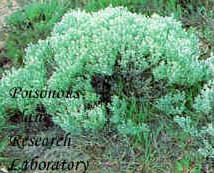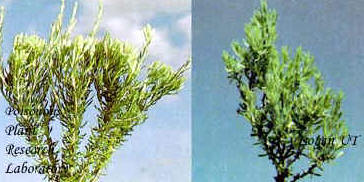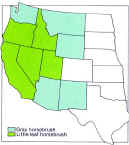|
 Two species of horsebrush that grow in the Great Basin region of the West are poisonous to sheep. Littleleaf horsebrush is commonly called coal-oil brush and spiny rabbitbrush. Spineless horsebrush is also called gray horsebrush. Two species of horsebrush that grow in the Great Basin region of the West are poisonous to sheep. Littleleaf horsebrush is commonly called coal-oil brush and spiny rabbitbrush. Spineless horsebrush is also called gray horsebrush.
Flower buds of littleleaf horsebrush (left) are first gray, then turn yellow just before the yellow flowers appear. Flowers quickly dry and turn brown. Spineless horsebrush (right) gets its silvery appearance from hair that cover stems and leaves. Leaves are about two cm long and are longer and broader than those of littleleaf horsebrush. Littleleaf horsebrush (below) is a strong-scented shrub that often reaches a height of 1 meter. This plant is in full bud. Stems are abundantly branched; dark-green leaves are slender and come to a sharp point. Spineless horsebrush (first picture) reaches a height of about 0.5 to 1 meter. It often is mistaken for sagebrush. Like littleleaf horsebrush, spineless horsebrush is a perennial in the sunflower family. Littleleaf horsebrush (below) is a strong-scented shrub that often reaches a height of 1 meter. This plant is in full bud. Stems are abundantly branched; dark-green leaves are slender and come to a sharp point. Spineless horsebrush (first picture) reaches a height of about 0.5 to 1 meter. It often is mistaken for sagebrush. Like littleleaf horsebrush, spineless horsebrush is a perennial in the sunflower family.
 Sheep that feed on horsebrush just following or Sheep that feed on horsebrush just following or
in conjunction with black sage (Artemesia
nova) and then are exposed to bright sunlight
may develop a characteristic swelling of the
head, called bighead. Sheep grazing the
horsebrush may die without developing
bighead. However, with care, many of these
sheep survive.
Most losses from horsebrush occur during
stormy periods when sheep change their
grazing habits as they are trailed through heavily
infested areas. Hungry sheep may also eat toxic
amounts of horsebrush after they are watered. The plant is especially dangerous during bud stage, perhaps because it is more palatable. All plant parts of both species are poisonous, but sheep eat only buds, leaves, and fine stems.
Where and When It Grows
Littleleaf horsebrush is most abundant on bench lands, well-drained slopes, and low elevations on sheep winter ranges. It is one of the earliest desert range plants to start growing in the spring and it is often green by late March and in full flower by June. Leaves dry and drop off in early July, and the plant is dormant until the next spring. Spineless horsebrush is most abundant in sagebrush areas and foothill regions. It starts growing later than littleleaf horsebrush and flowers in June or July. It usually remains green until fall.
How It Affects Livestock
Horsebrush causes severe liver damage when large amounts are eaten, and sheep may die within a day or two. Survivors, if pregnant, often abort and may require weeks to recover. Sheep eating lesser amounts of the plant may become sensitive to sunlight and develop various degrees of photosensitivity. Photosensitization results in swelling and edema accumulation in the ears, lips and exposed skin of the head that is commonly called bighead. Horsebrush toxins have been identified as resins and furanoeremophilanes (furanosesquiterpenes) such as tetradymol. These toxins are metabolized by hepatic mixed function oxidases and they have been shown to uncouple oxidative phosphoralation. Secondary photosensitivity occurs when unsecreted phylloerythrin accumulation in tissues. Sheep vary considerably in their susceptibility to horsebrush, but often less than 0.5 kg of the littleleaf brush will cause bighead. Larger amounts may result in death. As it is less toxic, nearly twice as much spineless horsebrush must be eaten to cause similar symptoms. The horsebrush toxins synergize with other sagebrush toxins, especially black sagebrush.
Signs and Lesions of Poisoning
- Loss of appetite
- Depression, lagging behind the herd
- Weakness, recumbency, and death may occur in severe cases or photosensitization
may develop
- Itching and uneasiness, swelling of lips, ears, eyelids and cheeks, serum may ooze
from sores and scabs
- Animal seeks shade
- Peeling of skin from face and ears
- Abortion may occur
- Liver swollen, engorged, and often shows severe fatty changes
- Kidneys show low grade nephritis
- Petechial hemorrhages can be found on serosal surfaces
How to Reduce Losses
Bighead is principally a trail disease. To prevent losses, avoid horsebrush ranges while trailing sheep. Do not let animals graze in infested areas immediately after watering or during stormy periods. Move affected sheep to shade as soon as you notice signs of bighead. Give them water and feed; supplemental hay may be beneficial. If possible, these sheep should be left undisturbed for a few days. An effective economical method for the control of horsebrush has not been developed. Chemical and mechanical control in the area where T. glabrata grows is economically and physically impractical.
|


 Two species of horsebrush that grow in the Great Basin region of the West are poisonous to sheep. Littleleaf horsebrush is commonly called coal-oil brush and spiny rabbitbrush. Spineless horsebrush is also called gray horsebrush.
Two species of horsebrush that grow in the Great Basin region of the West are poisonous to sheep. Littleleaf horsebrush is commonly called coal-oil brush and spiny rabbitbrush. Spineless horsebrush is also called gray horsebrush. Littleleaf horsebrush (below) is a strong-scented shrub that often reaches a height of 1 meter. This plant is in full bud. Stems are abundantly branched; dark-green leaves are slender and come to a sharp point. Spineless horsebrush (first picture) reaches a height of about 0.5 to 1 meter. It often is mistaken for sagebrush. Like littleleaf horsebrush, spineless horsebrush is a perennial in the sunflower family.
Littleleaf horsebrush (below) is a strong-scented shrub that often reaches a height of 1 meter. This plant is in full bud. Stems are abundantly branched; dark-green leaves are slender and come to a sharp point. Spineless horsebrush (first picture) reaches a height of about 0.5 to 1 meter. It often is mistaken for sagebrush. Like littleleaf horsebrush, spineless horsebrush is a perennial in the sunflower family. Sheep that feed on horsebrush just following or
Sheep that feed on horsebrush just following or